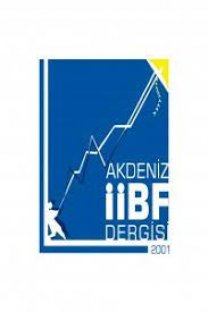Yolsuzluğun Nedenleri Üzerine Ampirik Bir Çalışma
An Empirical Investigation on the Determinants of Corruption
___
- ALESINA, A. ve B.WEDER (1999) Do Corrupt Governments Receive Less Foreign Aid?, National Bureau of Economic Research Working Paper, No.7108.
- BRAUN, M. ve R. DI TELLA (2000) Inflation and Corruption (Yayımlanmamış Makale), Massachussets: Harvard University.
- CİNGİ, S. (1994) Yolsuzluk Olgusu ve Ekonomik Analizi Üzerine Notlar, Hacettepe Üniversitesi İktisadî ve İdarî Bilimler Fakültesi Dergisi, Cilt 12, s.:1-18.
- COASE, R. (1979) Payola in Radio and Television Broadcasting, Journal of Law and Economics 22, pp.269-328
- FRIEDMAN, E., S. JOHNSON, D. KAUFMANN ve P. ZOİDO-LOBATON (2000) Dodging the grabbing hand: the determinants of unofficial activity in 69 countries, Journal of Public Economics 76, pp.459-493.
- GREENE, H. WILLIAM (1993) Econometric Analysis. New York: Macmillan Publishing Company.
- GUPTA, S., L. de MELLO ve R. SAHARAN (2000) Corruption and Military Spending, International Monetary Fund Working Paper, No.23.
- GUPTA, S., H. DAVOODI ve E. TIONGSON (2000) Corruption and the Provision of Health Care and Education Services, International Monetary Fund Working Paper, No.116.
- KNACK, S. ve P. KEEFER (1995) Institutions and Economic Performance: Cross Country Tests Using Alternative Institutional Measures, Economics and Politics, Vol.7, No.3, pp.207-227.
- LAFFONT, J. ve T. N'GUESSAN (1999) Competition and Corruption in an Agency Relationship. Journal of Development Economics, Vol.60, pp.271-295.
- LA PORTA, R., F.L. de SILANES, A. SHLEIFER ve R. VISHNY (1999) The Quality of Government, Journal of Law, Economics, and Organization, Vol. 15, N.1, pp.222- 279.
- MAURO, P. (1998) Corruption and the Composition of Government Expenditure, Journal of Public Economics, Vol. 69, pp.263-279.
- MURPHY, K., A. SHLEIFER ve R. VISHNY (1991) The Allocation of Talent: Implications for Growth. The Quarterly Journal of Economics, May, pp.503-530.
- RAUCH, J. ve P.B. EVANS (2000) Bureaucratic Structure and Bureaucratic Performance in Less Developed Countries, Journal of Public Economics,79,pp.49-71
- RODRIK, D. (1997) What Drives Public Employment?, National Bureau of Economic Research Working Paper, No. 6141.
- SCHNEIDER, F. ve D. ENSTE (2000) Shadow Economies Arounda the World: Size, Causes and Consequences, Internationaml Monetary Fund Working Paper, No. 26.
- SHLEIFER, A. ve R. VISHNY (1993) Corruption, The Quarterly Journal of Economics, August, pp.599-617.
- SWANY, A., S. KNACK, Y. LEE ve O. AZFAR (2001) Gender and Corruption, Journal of Development Economics, Vol.64, pp.25-55.
- TANZI, V. ve H. DAVOODI (1997) Corruption, Public Investment and Growth, International Monetary FundWorking Paper, No.139.
- TOLLISON, R. (1982) Rent Seeking: A Survey, Kyklos, Vol.35, No.4, pp.575-602.
- TOSUN, M. U. (2001) Bir Kamusal Başarısızlık Ürünü: Yolsuzluk, (Yayımlanmamış Doktora Tezi) Ankara: Hacettepe Üniversitesi.
- TREISMAN, D. (2000) The Causes of Corruption: a Cross-National Study, Journal of Public Economics, 76, pp.399-457.
- VAN RIJCKEGHEM C. ve B. WEDER (1997) Corruption and the Rate of Temptation: Do Low Wages in Civil Service Cause Corruption, International Monetary Fund Working Paper, No. 73.
- WEI, SHANG-JIN (2000) Natural Openness and Good Government, National Bureau of Economic Research Working Paper, No. 7765.
- WORLD BANK (1999) 1999 World Development CD-ROM, Washington.
- ISSN: 1302-9975
- Yayın Aralığı: Yılda 2 Sayı
- Başlangıç: 2001
- Yayıncı: Akdeniz Üniversitesi
Türk Siyasal Sisteminde Siyasal Partiler ve Kentleşmenin Kutuplaşma Sürecine Etkileri
Tarım Arazilerinin Kamulaştırılmasında Değer Biçme: Akyar Barajı Örneği
Kültürel Sinerji: Uluslararası İşletmelere Yönelik Kavramsal Bir İrdeleme
KKTC'de Kamu Kesimi Dengesi ve Kamu Finansmanı Sorunları
Yolsuzluğun Nedenleri Üzerine Ampirik Bir Çalışma
Avrupa Birliği Eğitim Semineri (Jean Monnet European Module): 2002-2003 Tanıtım Notları
Konsolide Bütçenin Başlangıç Değerlerinin Uygulama Sonuçları ile Birlikte Değerlendirilmesi
